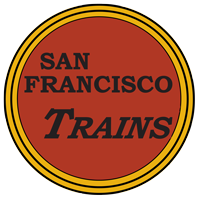This page features landmarks from San Francisco’s railroad past that you can still see in the City (or its immediate vicinity) today.
Table of contents
- Bayshore Roundhouse
- Fort Mason Tunnel
- Fourth Street Interlocking Tower
- Pier 43 Barge Slip and Ferry Arch
- Private Car “WaaTeeKaa”
- Santa Fe Barge Slip
- Southern Pacific Headquarters
- Southern Pacific Hospital
- State Belt Roundhouse
Street Railway and Cable Railway Landmarks
- Cable Car Signal Tower
- MUNI Cameron Beach Yard
- Clay Street Hill Railroad Plaque
- Ferries and Cliff House Railway Car Barn and Powerhouse
- Fort Mason Streetcar Shelter
- Geary Car House
- Geary Street, Park & Ocean Railroad Car Barn
- Golden Gate Park Streetcar Shelter
- Market Street Railway Substation
- MUNI Potrero Yard
Railroad Marine Vessels
- Southern Pacific Ferry “Eureka”
- Western Pacific Tugboat “Hercules”
- Southern Pacific Ferry “Santa Rosa”
Bayshore Roundhouse
Brisbane, CA
Largest remaining roundhouse in the state. One of two remaining in the immediate vicinity of San Francisco.

Fort Mason Tunnel
Fort Mason
Railroad tunnel used by the State Belt to reach Fort Mason and the Presidio. Featured in the movie Dirty Harry.

Fourth Street Interlocking Tower
5th and Townsend Streets
Interlocking tower constructed in the early Seventies to handle train movements at SP’s 3rd & Townsend (and soon after, 4th & Townsend) terminal. Replaced an earlier structure that was actually located on 4th Street, hence the name. Now used by Caltrain as a yardmaster’s office.

Pier 43 Barge Slip and Ferry Arch
Pier 48, Embarcadero
Probably the most exquisite barge slip in the City, featuring a large arch. Used by the State Belt to receive cars from multiple railroads.

Private Car “WaaTeeKaa”
50 Beale Street
Representation of the private car used by the Bechtel family in the 1920s on large construction jobs. Restored “WaaTeeKaa” is a former C.St.P.M.&O. car and now houses the Bechtel Museum.

Santa Fe Barge Slip
Pier 52, China Basin
Santa Fe’s second barge slip at China Basin (their first was at the mouth of the Mission Creek Channel).

Southern Pacific Headquarters
1 Market Street
Systemwide headquarters of the Southern Pacific Transportation Company. Built 1916. Sold in 1998, after the 1996 UP merger. Continues to serve as an office building for its current tenants.

Southern Pacific Hospital
1400 Fell Street
Hospital building constructed by the Southern Pacific Railroad in 1908 for treatment of employees. Closed in 1968. Now houses Mercy Terrace, an assisted living community.
Featured in the Movie D.O.A..

State Belt Roundhouse
1500 Sansome Street
San Francisco’s other surviving roundhouse. Former roundhouse, sandhouse, and office of the State Belt Railroad, built in 1918. Converted to an office building.

Street Railway and Cable Railway Landmarks
Cable Car Signal Tower
California & Powell Streets
Controls the intersection of the California Street and Powell Street cable car lines.

MUNI Cameron Beach Yard
Geneva & San Jose Avenues
Used to have a brick car barn, but it was demolished after sustaining heavy damage in the 1989 Loma Prieta Earthquake. The yard’s historic office building and adjacent powerhouse survive and now house a youth arts center. MUNI still uses the yard out back.

Clay Street Hill Railroad Plaque
Clay & Kearney streets
California Historical Landmark #500. Commemorates the site of the eastern terminus of the world’s first cable railroad, the Clay Street Hill Railroad.

Ferries and Cliff House Railway Car Barn and Powerhouse
1201 Mason Street
Built 1887. Still serves as a car barn for San Francisco’s three remaining cable car lines, and also hosts the Cable Car Museum.

Fort Mason Streetcar Shelter
MacArthur & Franklin Streets
A streetcar shelter constructed by MUNI for use by ‘H’ line streetcars.

Geary Car House
Geary Boulevard & Presidio Avenue
A former MUNI car barn and office building. Now used by buses.

Geary Street, Park & Ocean Railroad Car Barn
Geary & Arguello Boulevards
Former car barn for the GSP&O.

Golden Gate Park Streetcar Shelter
7th & Fulton Streets
Shelter for the Powell Street Railroad’s Golden Gate Park stop. Built 1889.

Market Street Railway Substation
1190 Fillmore Street
Powered the Market Street Railway’s Fillmore Street line.

MUNI Potrero Yard
Mariposa & Hampshire Streets
Car barn and yard formerly used by streetcars, now used for trolley buses.

Railroad Marine Vessels
Maritime operations were a major part of San Francisco’s railroad history, and a few railroad-owned ferries and tugboats can still be seen on display in the City.
Southern Pacific Ferry “Eureka”
Hyde Street Pier
The last intact wooden-hulled sidewheel steamer afloat in the continental U.S., Eureka is significant as an example of a type of steamer that led U.S. inland waterborne commerce into the industrial era.

Western Pacific Tugboat “Hercules”
Hyde Street Pier
Constructed in 1907, Hercules broke many towing records, beginning with her maiden voyage through the Straits of Magellan towing her sister ship.

Southern Pacific Ferry “Santa Rosa”
Pier 3
Built in 1927 for SP subsidiary Golden Gate Ferries. Currently serves as Hornblower Cruises’ headquarters.

